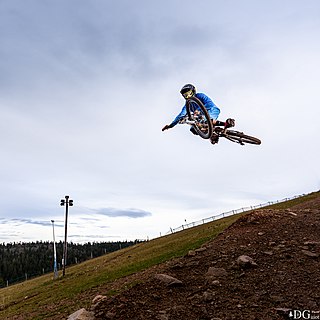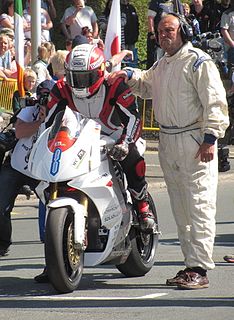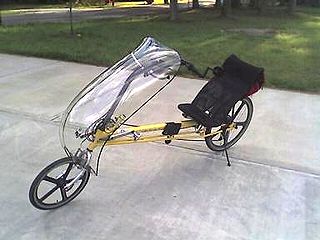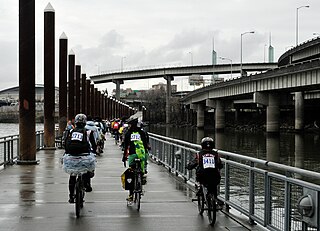
A mountain bike (MTB) or mountain bicycle is a bicycle designed for off-road cycling. Mountain bikes share some similarities with other bicycles, but incorporate features designed to enhance durability and performance in rough terrain, which makes them heavier, more complex and less efficient on smooth surfaces. These typically include a suspension fork, large knobby tires, more durable wheels, more powerful brakes, straight, extra wide handlebars to improve balance and comfort over rough terrain, and wide-ratio gearing optimised for topography and application. Rear suspension is ubiquitous in heavier-duty bikes and now common even in lighter bikes. Dropper posts can be installed to allow the rider to quickly adjust the seat height.

Critical Mass is a form of direct action in which people meet at a set location and time and travel as a group through their neighbourhoods on bikes. The idea is for people to group together to make it safe for each other to ride bicycles through their streets, based on the old adage: there's safety in numbers.

The penny-farthing, also known as a high wheel, high wheeler or ordinary, was the first machine to be called a "bicycle". It was popular in the 1870s and 1880s, with its large front wheel providing high speeds and comfort.

Mountain biking is a sport of riding bicycles off-road, often over rough terrain, usually using specially designed mountain bikes. Mountain bikes share similarities with other bikes but incorporate features designed to enhance durability and performance in rough terrain, such as air or coil-sprung shocks used as suspension, larger and wider wheels and tires, stronger frame materials, and mechanically or hydraulically actuated disc brakes. Mountain biking can generally be broken down into five distinct categories: cross country, trail riding, all mountain, downhill, and freeride.

Longboarding is riding on a longboard. Longboards vary in shape and size. Compared to skateboards, longboards are more stable, and have more traction and durability due to larger wheel size and lower wheel durometers. Generally, a skateboard comes in between 28-34 inches long and 7-10 inches wide, while a longboard has a length of 35-60 inches and a width of 9-10 inches. Many longboards use trucks (axles) that have different geometric parameters than skateboards. There are a variety of longboard disciplines, and types of longboards. Longboarding has competitive races down hill where riders can reach speeds exceeding 60 mph (97 km/h). The wider turning radius of longboards, as well as their ability to coast long distances make them more suitable for cruising and commuting on streets than regular skateboards.

Street luge is an extreme gravity-powered activity that involves riding a street luge board down a paved road or course. Street luge is also known as land luge or road luge. Like skateboarding, street luge is often done for sport and for recreation.

A tall bike is an unusually tall bicycle often constructed by hobbyists from spare parts. Typically, two conventional bicycle frames are connected, by welding, brazing, or other means, one atop the other. The drive train is reconfigured to connect to the upper set of pedals, and the controls are moved to the upper handlebar area.

Downhill mountain biking (DH) is a genre of mountain biking practiced on steep, rough terrain that often features jumps, drops, rock gardens and other obstacles. Jumps can be up to and including 12 meters, and drops can be greater than 3 meters.

Freeride is a discipline of mountain biking closely related to downhill biking, dirt jumping, and freestyle BMX. When riding a freerider one focuses on tricks, style, and technical trail features. Freeride is now recognized as one of the most popular disciplines within mountain biking.

This is a glossary of terms and jargon used in cycling, mountain biking, and cycle sport.

MotoCzysz was an American motorcycle company based in Portland, Oregon that intended to compete in MotoGP. The C1 prototype engine was designed with perfect balance not needing a balance shaft. Some of the patented innovations included a slipper clutch with twin clutches, and a unique front suspension. The business also developed a successful electric racing motorcycle, the E1pc.

The World Naked Bike Ride (WNBR) is an international clothing-optional bike ride in which participants plan, meet and ride together en masse on human-powered transport, to "deliver a vision of a cleaner, safer, body-positive world."

The Seattle to Portland, or STP, is an annual one- or two-day supported bicycle ride from Seattle, Washington, to Portland, Oregon, in the United States. The STP "is considered one of the 10 biggest recreational bicycle rides in the country, drawing riders from across the nation and from other nations", and has been operating since 1979. The ride is organized by the Cascade Bicycle Club. It is approximately 206 miles (332 km) in length. Most riders complete the distance in two days; however, 1854 of the nearly 8000 riders attempted to ride in one day (2018).
Turner Suspension Bicycles, Inc is an American bicycle frame manufacturer, based in Murrieta, California, specializing in full suspension mountain bikes. Turner Bikes was founded in 1994 by David Turner, a former professional mountain bike rider who had ridden for the Marin and Mongoose teams, amongst others. Turner had also worked with Horst Leitner at AMP Research whilst Horst developed the Horst Link suspension design.

Sam Hill, is an Australian professional enduro mountain biker and former professional downhill racer. He was two time consecutive UCI World Downhill Champion during years 2006–2007 for Iron Horse racing team. He won the 2010 world championships in Mont Saint Anne, riding for the Monster Energy Specialized team on a Specialized Demo 8 II. He also won the 2007 and 2009 UCI Elite Men's Downhill World Cup (Overall). In December 2012 it was announced that Hill had signed for the Chain Reaction Cycles/Nukeproof team. As of 2016, Hill has switched to racing enduro and won the 2017 Enduro World Series overall title. In the same year he raced the Downhill World Championships in Cairns, Australia on his enduro bike where he finished sixth.

Bicycle use in Portland, Oregon has been growing rapidly, having nearly tripled since 2001; for example, bicycle traffic on four of the Willamette River bridges has increased from 2,855 before 1992 to over 16,000 in 2008, partly due to improved facilities. The Portland Bureau of Transportation says 6% of commuters bike to work in Portland, the highest proportion of any major U.S. city and about 10 times the national average.

TerraCycle, Inc. is a designer and manufacturer of recumbent bicycle parts based in Portland, Oregon in the United States. TerraCycle is known for its idlers and Cargo Monster load-carrying extensions.

People's Bike Library of Portland, also known as Zoobomb Pyle or simply "the pile", is a 2009 steel and gold leaf sculpture by local artists Brian Borrello and Vanessa Renwick, located in Portland, Oregon, in the United States. It was erected in collaboration with the Zoobomb bicycling collective, and serves as a bicycle parking rack, a "lending library" for weekly bike riders, and a monument to the city's bike culture. The sculpture features a two-story spiral pillar with a gold-plated small bicycle on top; bicycles intended for Zoobomb riders are locked to the pillar and base, which has metal loops serving as hooks.

The Worst Day of the Year Ride is the annual cycling event held in Portland, Oregon, in the United States.

Biketown, also known as Biketown PDX, is a bicycle-sharing system in Portland, Oregon, that began operation on July 19, 2016. The system is owned by Portland Bureau of Transportation (PBOT) and operated by Lyft, with Nike, Inc. as the title sponsor. At launch, the system had 100 stations and 1,000 bicycles serving the city's central and eastside neighborhoods, with hopes to expand outward.




















